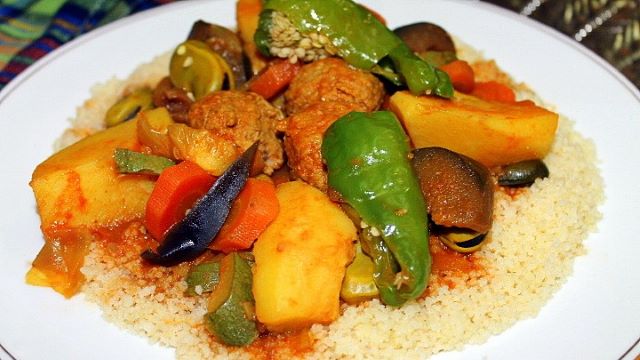Steam rises from a shallow platter, curling around tender cuts of lamb and a cascade of golden semolina. Beneath, a broth rich with cumin, coriander, cinnamon, and turmeric carries the essence of Algeria’s culinary heritage. Across the Maghreb, few dishes command the same cultural significance as couscous, and in Algeria, it remains as much a symbol of community as it is a daily staple.
The dish’s origins trace back centuries to the Berber peoples, whose methods of steaming semolina over aromatic stews were passed from generation to generation. Today, it appears on tables during weddings, religious festivals, and ordinary family gatherings alike. The preparation is often an act of quiet ceremony—each grain of couscous steamed until light and separate, each cut of meat simmered slowly until yielding to the touch.
Spices anchor the flavor profile. In Algerian kitchens, ground cumin lends earthiness, coriander adds a citrus note, cinnamon brings warmth, and turmeric imparts both color and a subtle bitterness. These are not mere accents but defining elements, infusing the lamb and vegetables during hours of gentle cooking. Carrots, zucchini, and turnip contribute their sweetness, while chickpeas offer texture and substance.
The traditional presentation is unhurried and deliberate. The couscous is mounded onto a large platter, a well formed in the center to cradle the stew. Garnishes of fresh parsley or cilantro provide contrast against the deep ochres and reds of the sauce. While recipes vary by region and household, the structure is enduring: grain, broth, meat, and vegetables in harmonious balance.
Couscous in Algeria is rarely prepared in isolation from its cultural setting. In the markets of Algiers or Constantine, the aroma of spice blends drifts from stalls, mingling with the scent of fresh herbs and the hum of conversation. Home kitchens often mirror this sensory tapestry, linking the meal to its broader cultural context.
In recent years, chefs and home cooks have adapted couscous to contemporary tastes and schedules, incorporating new vegetables or leaner cuts of meat. Yet the traditional lamb-and-vegetable preparation remains a touchstone, celebrated for its ability to connect the present to the past through flavor, technique, and shared experience.
Sources:
- Davidson, Alan. The Oxford Companion to Food. Oxford University Press, 2014.
- Achour, Malika. “Le Couscous: Patrimoine Culinaire Algérien.” El Watan, March 15, 2024.
- Wolfert, Paula. The Food of Morocco. HarperCollins, 2011.

